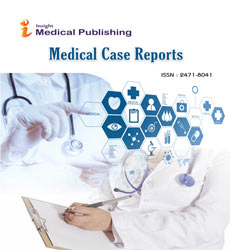Potential Causality Between Autoimmune Atrophic Gastritis (AAG) and CrohnâÂÂs Disease
Kevork Hagop
Department of Internal Medicine, University of Balamand, Beirut, Lebanon
Published Date: 2024-11-25DOI10.36648/2471-8041.10.6.406
Kevork Hagop*
1Department of Internal Medicine, University of Balamand, Beirut, Lebanon
- *Corresponding Author:
- Kevork Hagop,
Department of Internal Medicine, University of Balamand, Beirut, Lebanon
E-mail: kervork@gmail.com
Received date: October 24, 2024, Manuscript No. IPMCRS-24-20061; Editor assigned date: October 28, 2024, PreQC No. IPMCRS-24-20061 (PQ); Reviewed date: November 11, 2024, QC No. IPMCRS-24-20061; Revised date: November 18, 2024, Manuscript No. IPMCRS-24-20061 (R); Published date: November 25, 2024, DOI: 10.36648/2471-8041.10.6.406
Citation: Hagop K (2024) Potential Causality Between Autoimmune Atrophic Gastritis (AAG) and Crohn’s Disease. Med Case Rep Vol.10 No.6: 406.
Description
Autoimmune Atrophic Gastritis (AAG) and Crohn’s disease, which both involve immune dysfunction, particularly a Th1- mediated immune response. AAG is a chronic autoimmune disorder where antibodies against parietal cells or intrinsic factor target the gastric oxyntic mucosa, resulting in gradual atrophy of the gastric corpus and, subsequently, reduced intrinsic factor production and gastric acid secretion. Conversely, Crohn’s disease is an Inflammatory Bowel Disorder (IBD) that mainly impacts the ileocecal area with discontinuous lesions and extensive inflammation.
Immune response as the common link
Both AAG and Crohn’s disease exhibit a shared pathogenic immune mechanism driven by the Th1 immune response. Th1 cells secrete vital pro-inflammatory cytokines, including IL-6 and IL-17A, which play a role in the development of both diseases. The involvement of Th17 cells, activated by IL-6, further reinforces this association. In AAG, Th1 responses lead to the formation of autoantibodies that target gastric parietal cells, while in Crohn’s disease, Th1 cytokines facilitate inflammation of the intestinal mucosa. Notably, both conditions demonstrate elevated IL-17A levels in the affected tissues, suggesting a common immune activation pathway.
The role of vitamin D deficiency
The article also search the possible influence of vitamin D deficiency on the development of both AAG and Crohn’s disease. Vitamin D is essential for sustaining immune tolerance and its deficiency may impair T-cell function, increasing the risk of autoimmune diseases. Both patients in the case reports exhibited vitamin D deficiency, which may have served as a trigger for the autoimmune reactions that lead to the simultaneous development of these two conditions.
The two cases detailed in the article demonstrate how AAG and Crohn’s disease can manifest concurrently in the same patient. The first case involved a 61-year-old male who exhibited classic symptoms of iron-deficiency anemia, heartburn, abdominal pain and watery diarrhea. The patient’s gastric mucosa displayed typical characteristics of AAG, while ileocolonoscopy revealed Crohn’s disease with granulomas in the ileocecal area. The second case involved a 65-year-old female with generalized fatigue, abdominal pain and peripheral neuropathy, with both AAG and Crohn’s disease identified through endoscopic and biopsy results.
Clinical implications and management
The simultaneous occurrence of AAG and Crohn’s disease carries significant clinical implications. Both conditions can worsen nutritional deficiencies, especially iron and vitamin B12. AAG induces iron deficiency due to reduced gastric acid production, whereas Crohn’s disease contributes to malabsorption of both iron and vitamin B12, particularly when the terminal ileum is compromised. The combined impact of these two disorders can lead to more severe anemia and neuropathy in affected individuals. Management of these patients should involve correcting iron and vitamin B12 deficiencies, along with treating Crohn’s disease using corticosteroids like budesonide.
Need for further research
While the article provides strong evidence for a possible causal link between AAG and Crohn’s disease, this hypothesis remains uncertain due to the absence of large-scale studies. The authors suggest that additional research, including prospective cohort studies, is necessary to examine the possible connection between these two diseases and their common immune mechanisms. For instance, monitoring patients with AAG over time to determine if they develop Crohn’s disease and vice versa, could yield more substantial evidence for this association. Furthermore, a better understanding of the immunologic mechanisms that underlie the connection between AAG and Crohn’s disease could help identify new therapeutic targets. Considering the shared Th1-mediated immune profile, therapies aimed at the IL-17 axis might be effective in treating both conditions simultaneously.
Conclusion
This article offers a new perspective on the potential link between Autoimmune Atrophic Gastritis (AAG) and Crohn’s disease. Both conditions are influenced by similar immune responses and may share common pathogenic mechanisms, such as Th1-mediated inflammation and vitamin D deficiency. The case presentations provide important insights into how these diseases may coexist and impact patients clinical outcomes, especially concerning nutritional deficiencies.
Nevertheless, more research is required to confirm the causal relationship between AAG and Crohn’s disease and to investigate potential therapeutic implications.

Open Access Journals
- Aquaculture & Veterinary Science
- Chemistry & Chemical Sciences
- Clinical Sciences
- Engineering
- General Science
- Genetics & Molecular Biology
- Health Care & Nursing
- Immunology & Microbiology
- Materials Science
- Mathematics & Physics
- Medical Sciences
- Neurology & Psychiatry
- Oncology & Cancer Science
- Pharmaceutical Sciences
